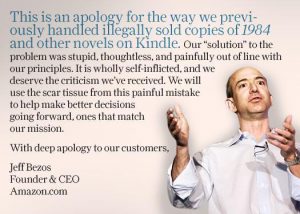5 Communication Lessons Companies Can Learn From Amazon
The space between the consumers and enterprises is rapidly shrinking, and to be one of the successful companies you need to learn a thing or two from the leaders.
Amazon’s emergence as one of the world’s most successful companies is generally attributed to it being incredibly visionary and extraordinarily customer-centric.
While it is undoubtedly praiseworthy, there are many more factors that contribute to the success of Amazon, say for their communication.
Here are 5 communication lessons companies can learn from Amazon –
-
The Art And Science Of Writing
Writing something is more challenging than talking about it and at Amazon they have to follow a set of writing rules. Strategies they plan or agenda to be discussed are written making the purpose of it clear. They follow the thumb rule of –
Think > Analyze > Anticipate
- Be specific about what you want to convey
- Skip the additional adverbs
- Stick to data
- Also, keep it crisp, clear and concise
What you can do –
Start writing your thoughts, plans, ideas and iterate. By penning down your thoughts you have a better chance of formulating them into a workable idea. Also, you get a fair idea of what you wish to convey.
Takeaway – Precise message leads to clear communication that leads to understanding resulting in saving on resources and enhanced decision making.
-
Don’t Just Listen, Understand
Thousands of managers each year at Amazon have to attend two-day call center training, a doctrine borrowed by the U.S. Marines.
Listen > Understand
The philosophy at Amazon is not only about listening but also about understanding the customer and no one does it better than Amazon.
What you can do –
Train your employees to be a better communicator and an even better listener, they need to know that they are here for the customer.
Takeaway – It’s easy to listen, but it is understanding the need of the customer to successfully better the organization.
-
Don’t Be Afraid To – Apologize
Apologizing is an open surrender telling the world you screwed up, however, a heartfelt apology represents that your organization really cares and Amazon understands if something goes wrong it needs to be amended.
A quick dry and inhuman press release of an apology made the situation worse but what turned customers around was the informal and sincere apology from the CEO, Jeff Bezos.

What you can do –
Mishaps are a part of life and if such a thing ever happens, acknowledge and apologize with true intent.
Takeaway – Be true to your customers.
-
Things That Won’t Change
“I very frequently get the question: ‘what’s going to change in the next 10 years?’ And that is a very interesting question; it’s a very common one. I almost never get the question: ‘what’s not going to change in the next 10 years?’ And I submit to you that that second question is actually the more important of the two – because you can build a business strategy around the things that are stable in time….in our retail business, we know that customers want low prices and I know that’s going to be true 10 years from now.”
“They want fast delivery, they want vast selection. It’s impossible to imagine a future 10 years from now where a customer comes up and says, ‘Jeff I love Amazon, I just wish the prices were a little higher [or] I love Amazon, I just wish you’d deliver a little more slowly.’ Impossible [to imagine that future].”
“And so the effort we put into those things, spinning those things up, we know the energy we put into it today will still be paying off dividends for our customers 10 years from now. When you have something that you know is true, even over the long-term, you can afford to put a lot of energy into it.”
This is what Amazon is working on – lowering prices, faster delivery, adding new products, communicating effectively.
What you can do –
Plan your strategy on things that won’t change even in the coming 10 years.
As we are talking communication here so let’s take an example of a communication medium, SMS. It has been in use since 1993, more than 25 years now and with time it has become the most powerful communication medium.
Takeaway – Putting your energies into something that customers will still care about in 10 years. If not, start working on things that will matter 10 years from now.
-
The Details Are In The Data
Amazon is the data-driven company. They don’t leave anything to chance, especially their customer communication. They analyze it with scientific discipline and an action plan is implemented based on the data.
What you can do –
Establish smart metrics > Use analysis in an active way > Automate
It enhances the efficient implementation of business decisions. Also, forces any employee to stop being complacent about their ideas or performances.
Takeaway – Analyze the resources you spend on communicating and does it result in tangible actions that drive results?
There’s no immediate action needed to be taken from these lessons from Amazon, a positive change in your outlook at your customer and internal communication will lead to the required actions. Take this as an opportunity to learn from the man himself who’s focused – only on the customer; we surely do 🙂
Views: 116
- best-practices
Copyright 2008-2025, Superheroes, Inc. | All rights reserved.